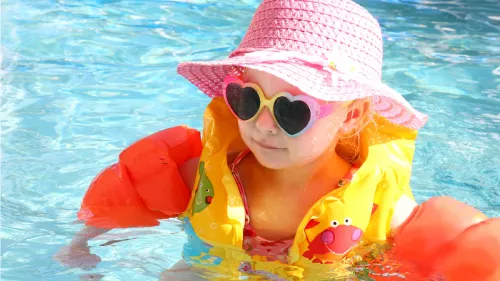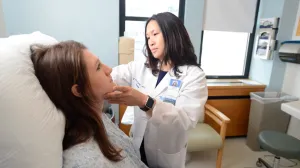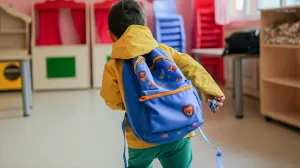
Severe sunburns aren't child's play. Sunburns in childhood can lead to everything from premature wrinkles to melanoma—the deadliest form of skin cancer. That's why it's never too early to protect your child's skin and teach them good sun safety habits. Tufts Medical Center pediatric dermatologist Dr. Sarah Robinson offers these important reminders for keeping your kids safe this summer, whether they're on the beach, at camp or just playing in the yard.
- All children and babies over the age of 6 months should wear sunscreen with SPF of 30 or higher at least 15 minutes before going outside—even when it's cloudy. We recommend physical blocking (mineral) sunscreen that contains zinc oxide or titanium dioxide, which are safe and provide broad-spectrum UVA and UVB coverage. Avoid spray sunscreens, which can be dangerous if inhaled. Remember to reapply sunscreen every 2 hours, especially after swimming or sweating. Babies under 6 months should be kept away from direct sunlight.
- Avoid the most intense afternoon sun. Encourage kids to play in shaded areas during peak sun hours between 10 am and 4 pm.
- Dress kids in lightweight, long-sleeved shirts and pants, along with wide-brimmed hats to protect their skin and eyes from harmful UV rays. Invest in a rash guard or swim shirt to protect skin while swimming.
- Children should wear sunglasses that block both UVA and UVB rays to protect their eyes from sun damage.
- Pay attention to medicines that may cause photosensitivity. Certain drugs, including some antibiotics, can increase the likelihood of sunburn. Check the warnings on medications and take extra care to protect their skin when outside.
- Reflective surfaces like water, sand and snow intensify the sun's rays, increasing the risk of sunburn. Sunburns can happen even when using a beach umbrella or sitting in the shade so you still need to slather on the sunscreen and wear protective clothing.
- Teach kids about the signs of sunburn, such as redness, pain and blisters, so they can recognize when they need to seek shade and apply sunscreen.
- Help kids learn to be aware of any changes in their skin. Show them how to check for any unusual moles or spots and to report them to an adult for further evaluation.
And perhaps most importantly, Dr. Robinson encourages caregivers to set a good example by practicing sun safety these habits themselves. Kids are more likely to develop good life-long sun safety habits when they grow up with adults who model smart sun safety choices.


